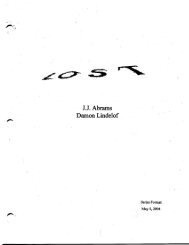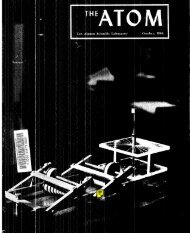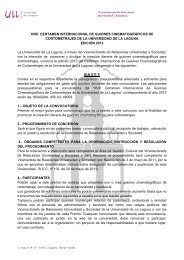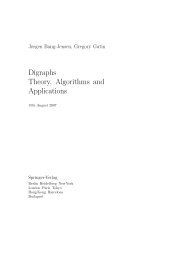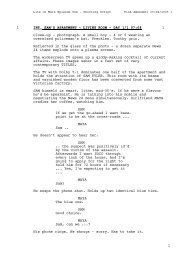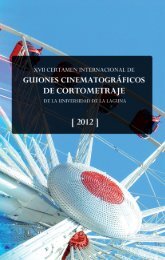You also want an ePaper? Increase the reach of your titles
YUMPU automatically turns print PDFs into web optimized ePapers that Google loves.
molecular speed, the gas in the left<br />
half of the box will be cooled and the<br />
gas in the right half will be heated.<br />
A number of devices have been proposed<br />
thatt according to their authors,<br />
could play the role of such a<br />
demon, but all of them failed to<br />
work because of certain unanticipated<br />
effects found in them.<br />
However, where physics faiis,<br />
mathematics may succeed. I want to<br />
suggest a device, free from demons<br />
and other evil spirits, that can be built<br />
even in a high school workshop. I'11<br />
present calcuiations that wili clearly<br />
show that this device can transfer<br />
heat from one body to another if they<br />
were heated equally at ihe outset.<br />
Before going into a description of<br />
my "perpetual enging" you'llhave to<br />
swallow a certain amount of math so<br />
that you can convince yourself that<br />
the reasoning and constructions to<br />
follow are correct. We'llbe dealing<br />
with the ellipse and its properties.<br />
By definitior', an ellipse is the<br />
cuwe formed by alJ the points in the<br />
plane such that the sum of their distances<br />
to two fixed points F, and F,<br />
is constant. Each of the points Fr and<br />
F, is called afocusi the constant sum<br />
oI the distances is usually denoted<br />
by 2a.<br />
This property is used by gardeners<br />
when they want to make oval flower<br />
beds. They drive a pair of sticks into<br />
the ground (at the foci), tie the ends<br />
of a rope to them, then take another<br />
stick with a sharp end and stretch<br />
the rope taut with this stick. If the<br />
stick is moved so that the rope remains<br />
taut, its sharp end traces an<br />
ellipse. The size and shape of the<br />
ellipse depend on the length of the<br />
rope and the distance between the<br />
foci. You can verify this on a sheet<br />
of paper using two pins and a pencil<br />
instead of sticks {{ig.2l.<br />
After you draw several ellipses<br />
you'll see that any ellipse is a closed<br />
convex curve that has a center of<br />
symmetry and two symmetry<br />
axes-the line FrF, and the Perpendicular<br />
bisector of the segmentFf 2.<br />
Also, it's easy to see that the sum of<br />
the distances to the foci is less than<br />
2a lor points inside the ellipse and<br />
greater than2a outside it.<br />
This information suffices to<br />
prove an important and not so obvious<br />
property of the ellipse: the segments<br />
that join the foci of an ellipse<br />
to an arbitrary point M on it make<br />
equal angles with the line that<br />
touches the ellipse at M.<br />
Comparing this property to the<br />
law of reflection of light-the angle<br />
of incidence equals the angle of reflection-we<br />
come up with the following<br />
formulation: a tay of light<br />
issuing from a focus of an eliipse after<br />
reflection from it hits the other<br />
focus.<br />
This is the "optical property" of<br />
the ellipse. It can be observed in nature:<br />
there are caves with eilipsoidal<br />
domes where you can find two<br />
spots/ far enough from each other,<br />
such that the voice of a person<br />
standing at one of these spots is<br />
heard at the other spot as if the<br />
speaker were just inches away. And<br />
some palaces and castles have halls<br />
intentionally designed to produce<br />
this effect.<br />
Since the optical property of the<br />
ellipse plays a major role in what<br />
follows, I'11give its proof-it's rather<br />
short and simple.<br />
Let l be the tangent to an ellipse<br />
at its point M lfig.3) and let cr and p<br />
be the angles between the linel and<br />
segments F, M and MF rlF, and F, are<br />
the foci). Reflect F, about I into F1',<br />
ioin F r'F2, and find the intersection<br />
pointNof this segment withl. SuPpose<br />
N * M; then N lies outside the<br />
ellipse (actually, the entire line 1,<br />
except its point M, lies outside the<br />
ellipse, because any ellipse is a convex<br />
curve). Therefore FrN + NF, > 2a<br />
: FrM + MFr. But by the construction,<br />
FrN = Fr'N a<strong>nL</strong>dFrM = Ft'M, so<br />
we get Fr'N + NFz> Fr'M + MF, ot<br />
Fr'M + MFr. Fr'F, whtch contradicts<br />
the Triangle Inequality for triatgle<br />
Fr'FrM. Therefore, points N<br />
andM must coincide, so FrMFr'is a<br />
straight line-that is, cr = P.<br />
Now let's bring our project to<br />
fruition. Take a sheet of good drawing<br />
paper, mark points F, and F, on<br />
it, and &aw two ellipses with the<br />
foci at these points, using a longer<br />
string the first time and a shorter<br />
one the second time. Draw the Perpendicular<br />
bisector to the segment<br />
FrErand erase a part of what we've<br />
drawn so as to obtain a "mushroom"<br />
like the one in figure 4.<br />
Figure 4<br />
Nowrollyour "blueprint" up, Put<br />
it in a cardboard tube, and go to the<br />
nearest metalworking shop. Ask<br />
that atin sheil be made in the shape<br />
obtained by rotating the curve in the<br />
blueprint about its symmetry axis<br />
f rF,<br />
(fiS. 5). The inside of the shell<br />
must be covered with a reflective<br />
coating. When the thing is readY,<br />
take it home. Now you are the<br />
Figure 2<br />
Figure 3 Figure 5<br />
JlJr.Y/AU0USI 1S04



